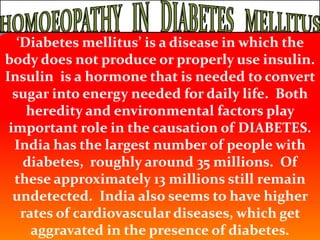
D I A B E T E S
- 1. HOMOEOPATHY IN DIABETES MELLITUS ‘Diabetes mellitus’ is a disease in which the body does not produce or properly use insulin. Insulin is a hormone that is needed to convert sugar into energy needed for daily life. Both heredity and environmental factors play important role in the causation of DIABETES. India has the largest number of people with diabetes, roughly around 35 millions. Of these approximately 13 millions still remain undetected. India also seems to have higher rates of cardiovascular diseases, which get aggravated in the presence of diabetes.
- 2. Some facts about Diabetes mellitus : Diabetics, particularly those who are insulin- dependent are : 25 times more prone to blindness than non-diabetics, 17 times more prone to kidney troubles, 40-50 times more prone to gangrene, Twice are likely to get heart diseases, Women are 50% more likely than men to have diabetes, Babies of diabetic women are often very large at birth, Chance of developing diabetes doubles with :- Every 20% excess weight Every decade of increasing
- 3. People with high risk of diabetes : All obese persons. People with sedentary habit. Children whose either of parents is diabetic. Pregnant women after 24 weeks of pregnancy. Persons with persistently non - healing wounds. Women who have undergone repeated abortions. Persons with high cholesterol/high blood pressure.
- 4. How Diabetes Mellitus occurs ? INSULIN is the hormone produced in the β Cells of pancreas in response to rising blood sugar level or increased food intake and is required for : Breakdown of glucose to energy Storage of fat and glycogen.
- 5. If the production of insulin is not adequate, glucose accumulates in the blood, especially after meals. Normally, the kidneys do not waste glucose by excretion in the urine, but if glucose rises too high, the kidneys cannot cope and glucose spills over into the urine with resultant glycosuria (i.e. Sugar in urine) To be able to excrete this urine, more water is required, which causes increased thirst, for which the person drinks often and this results in frequent urination. In diabetes, the body fats i.e. cholesterol & triglycerides are increased which may damage blood vessels, cause thrombosis (clotting of blood), especially in the blood vessels supplying nutrition to the heart. A GLUCOSE Tolerance Test will confirm whether a person has Diabetes mellitus or not. ( Normal glucose level is between 3 – 7 mmol/litre).
- 6. Types of DIABETES : Type 1. Insulin Dependent Diabetes Mellitus (IDDM) in which patients develop diabetes at less than 15 years of age and Insulin treatment is mandatory. Type 2. Non – insulin Dependent Diabetes Mellitus (NIDDM) is generally seen in adults after the age of 40. Most of them may be overweight with only a relative shortage of insulin. It can be treated without insulin.
- 7. Symptoms : PROFUSE THIRST. FREQUENT URINATION. EXTREME HUNGER. SUDDEN/DRAMATIC WEIGHT LOSS. WEAKNESS/EASY FATIGUE. BLURRED VISION IRRITABILITY.
- 8. SIGNS Type 1 Diabetes Mellitus Dry tongue Dry skin Sunken eyeballs Increased breathing Loss of weight etc. Type 2 Diabetes Mellitus Non – healing ulcer Non healing skin infections Fungal infections Itching of private parts Burning pain or numb feeling in the feet/hands Giddiness etc.
- 9. COMPLICATIONS Blindness Cataract Diabetic foot gangrene Peripheral neuropathy Heart attack and Heart failure Kidney failure Boils, ulcers, carbuncles, fungal infections Alternate diarrhoea and obstinate constipation Diabetic coma Bronchopneumonia
- 10. Management of Diabetes Mellitus : Diabetes mellitus rests on a tripod and its management therefore takes stock of these three pedestrals i.e. Diet, Exercise and Drugs. Some of the general guidelines for effective management of this disease are : Carbohydrate/fat intake to be moderated. Exercise regularly at least 30 min/day 5-7 days a week. Practice Yoga regularly. Keep a check on your weight, regularly. Overweight diabetics must lose a certain amount of weight. Avoid fried/fatty foods, sweets, fast foods. Avoid mental stress. Avoid cakes, chocolate, honey etc. Must eat frequently i.e. 3 regular meals, with 3 snacks in between.
- 11. Useful homoeopathic remedies : In Homoeopathy, all chronic diseases including Diabetes mellitus are treated by considering the totality of symptoms of the patients which include the presenting complaints, physical and mental characteristic features etc. Such medicines are called constitutional medicines, which if properly chosen, may take care of the complaints of the patients including reducing the blood sugar. However, some of the homoeopathic medicines which are empirically prescribed to reduce the blood sugar are –Abromaaugusta Q, Syzygiumjambolamum Q, Gymnemasylvestre Q, Cephalandraindica Q, Thyroidinum 6, 30, 200, Insulinum 6, 30, 200 etc.
- 12. Note :- For the effective treatment of Diabetes Mellitus, qualified Homoeopathic physicians should be consulted. General instructions The medicines can be dispensed in small globules made up of cane sugar or in plain drinking water. Medicines must be kept in a cool, dry place away from exposure to sun. Medicines must be kept away from strong smelling substances like camphor, menthol, etc. Mouth and tongue should be clean before taking medicines. Homoeopathic medicines act better in patients who are not addicted to tobacco products. Patient should avoid taking cigarette, bidi, paanmasala, alcohol and narcotics, etc. Strong smelling substances like onion, garlic, etc. May be taken half an hour before / after taking homoeopathic medicines. Medicines should not be taken if the white globules are discoloured. or sediments appear in the mother tincture/ liquid medicine. During homoeopathic treatment, no other medicines should be taken, unless urgently required.